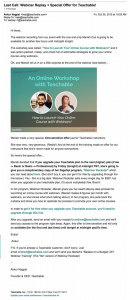
If you had a phone in the time before “Do Not Call” lists, chances are, you had your dinner interrupted more than once by a telemarketer trying to sell you something you probably never needed.
Although cold calling and sending emails to strangers used to be the way to sell, those methods are now less effective than ever. An uninvited call is only 3% effective, and that’s if your call is even answered.
Fortunately, there’s an answer to the death of the old ways of selling: social selling.
What Is Social Selling?
Social selling involves the use of social media to directly interact with potential customers in order to develop and nurture relationships as part of the sales process. Essentially, it involves taking your company or brand’s online presence and using it to help improve the trust and communications people have with you.
While this may seem like a radical idea to some, social selling isn’t revolutionizing the sales process. Instead, it’s a natural evolution into the constantly changing state of the buyer’s journey. Now, that journey takes place across multiple devices in a mostly mobile world. Social selling adapts to these new habits.
How to Use Social Selling
Social selling shouldn’t be used as a way to try to make your brand go viral or gain a ton of followers. Thousands of followers mean nothing to you if they don’t convert.
Instead, social selling should be focused on getting a response from people and generating leads by making prospective customers curious enough to interact with you. Your social media presence should be focused on generating solid leads back to your main site or business.
But, how do you generate leads? You can accomplish this with three steps:
- Give Prospective Customers a Reason to Bite. Use intriguing headlines or attractive images to catch the reader’s attention and make a promise or offer of interest to them. Just think: What information can you offer to help them with a problem? How can you satisfy a need?
- Hook the Customers With Curiosity. If you promised something intriguing in the headline or image to make a prospect click, make sure you immediately deliver a preview of what was promised. It’s a small, but powerful way to keep a promise with a result.
- Give the Customers an Irresistible Reason to Act. By now you know a prospect is curious, so give them a strong CTA they can act on. But, be careful. This is where you want to generate your lead, not risk their trust with a sales pitch. Instead, give a CTA that will satisfy their curiosity with an option for more details.

Optimizing Your Social Strategy
While it’s important to be a social chameleon in sales, the most important aspect of social selling is to have a plan, which should be formed around your audience. After all, a random strategy can lead to random results.
Find Your Audience
Take a look at who has interacted with your company or shop in the past. This should give you a good idea of the age range and overall demographics of your customers.
The next step is to create buyer personas for your ideal customers, and then use these personas to craft a strategy.
But, be sure to identify the best prospects. While it may be tempting to target or contact anyone who has ever interacted with your brand, it’s best to take a step back and focus on your most current customers in order to create your personas.
Figure out Your Platform
Based on your personas, the next step is to identify which social media platform to focus on the most. Just like your personas, each social media site contains a different demographic of users.
Percentage of Total Internet Users on Social Media
Stats via PEW Research Center
Now, I’m not saying that you only have to choose one social media platform to work with. But, you should place most of your focus on the sites that contain the majority of your prospective customers.
You should also keep in mind the environment of each platform. For example, LinkedIn is a professional site where you can post longer, more informative content. Facebook is also a good place for more content, but it’s much more casual.
Twitter, on the other hand, is meant solely for short, humorous quips that can help build your brand’s personality. Pinterest and Instagram are mostly visual and help you display products in a creative and attractive way. Ultimately, what sites you choose to focus your social media strategy on should depend on two things: the demographics of your prospective customers and the purpose of your brand or company.
Ultimately, what sites you choose to focus your social media strategy on should depend on two things: the demographics of your prospective customers and the purpose of your brand or company.
Additional Tips for Social Selling
- Give Your Prospective Customers Incentives. Everyone loves a contest if it means a chance to win something. Plus, a lot of social media contests carry the condition that you have to share a post in order to enter, spreading awareness of your company even further.
- Encourage Employees to Share. 90% of an employee’s social audience is new to your brand or company. Combine that with the fact that people are 4x more likely to buy something referred by a friend, and you have the potential to reach a huge audience at no cost to you.
- Don’t Be Afraid to Study the Competitor. Check out the profiles of your competitors to see what posts are getting their potential customers to engage. While you don’t want to copy the competition directly, it’s good to see what’s trending or what they’re up to (and maybe even what you can do better).
- Monitor Your Mentions. Set up alerts with tools like Google Alerts or Mention to see when people talk about your brand or company. Then, engage with those mentioning you. Whether it’s good or bad, people on social media want to talk, so use it as an opportunity to smooth over any customer issues or network with others.
(46)







